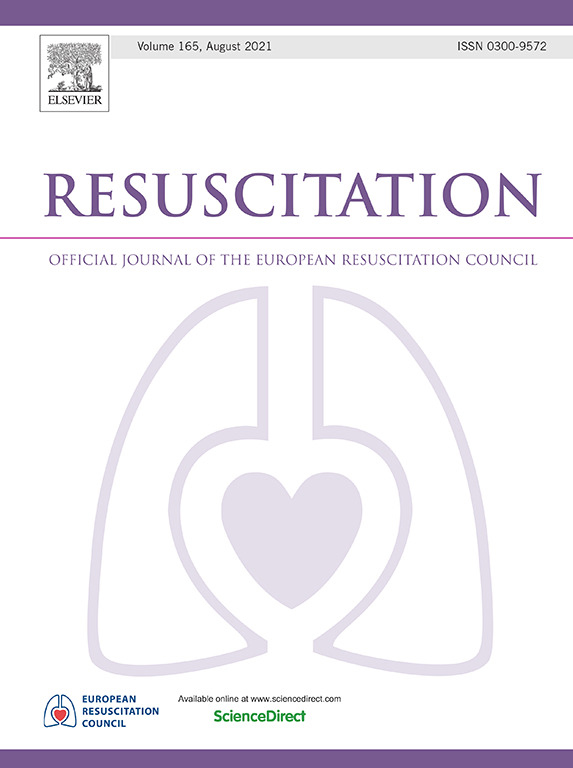Intramuscular adrenaline to improve outcomes following cardiac arrest – An experimental porcine study
IF 4.6
1区 医学
Q1 CRITICAL CARE MEDICINE
引用次数: 0
Abstract
Aim
To investigate early intramuscular adrenaline as an add-on treatment for cardiac arrest in a clinically relevant porcine model. We hypothesized that intramuscular adrenaline would improve return of spontaneous circulation (ROSC) compared to placebo.
Methods
36 pigs (38–42 kg) were subjected to hypoxia induced cardiac arrest for 3.5 min. During resuscitation, the pigs were randomized to either 0.125 mg/kg (0.125 mL/kg) intramuscular adrenaline or placebo 0.125 mL/kg normal saline. Both groups underwent basic life support followed by advanced life support including intravenous adrenaline 5 min after intramuscular adrenaline. Pigs achieving ROSC underwent one hour of intensive care. The primary outcome was ROSC.
Results
The ROSC rate was 4/18 (22 %) in the placebo group and 4/18 (22 %) in the intervention group (OR = 1.00 95 %CI [0.15;6.55], p = 1.00). There was no difference in coronary perfusion pressure or cerebral oxygen tension (difference: 0.71 mmHg [95 %CI: −7.25; 8.67], p = 0.86 difference: 3.0 mmHg [95 %CI: −7.68; 13.69], p = 0.57). Adrenaline blood concentrations were significantly higher in the intervention group 30 min (difference: 9.44 nmol/L [95 %CI: 3.42; 15.5] p = 0.009) and 60 min after ROSC (difference: 15.9 nmol/L [95 %CI: 8.51; 23.4] p = 0.002). There was a significantly higher cardiac output in the intervention group 60 min after ROSC (difference: 2.58 L/min [95 %CI: 0.78; 4.37] p = 0.013).
Conclusion
Early intramuscular injection of adrenaline 5 min prior to intravenous adrenaline did not increase the ROSC rate but resulted in a prolonged absorption with higher adrenaline levels at 30 and 60 min after ROSC.
肌肉注射肾上腺素改善心脏骤停后的预后-一项实验性猪研究。
目的:探讨早期肌内注射肾上腺素对猪心脏骤停的辅助治疗作用。我们假设与安慰剂相比,肌内肾上腺素可以改善自发循环(ROSC)的恢复。方法:36头猪(38 ~ 42 kg)缺氧致心脏骤停3.5 min。复苏期间,猪被随机分配至0.125 mg/kg (0.125 ml/kg)肌内肾上腺素组或0.125 ml/kg生理盐水安慰剂组。两组均接受基础生命支持,随后进行高级生命支持,包括肌内注射肾上腺素后5分钟静脉注射肾上腺素。达到ROSC的猪接受了1小时的重症监护。主要结果是ROSC。结果:安慰剂组ROSC率为4/18(22%),干预组为4/18 (22%)(OR = 1.00 95%CI [0.15;6.55], p = 1.00)。冠状动脉灌注压和脑氧压无差异(差异:0.71 mmHg [95%CI: -7.25;8.67], p = 0.86差异:3.0 mmHg [95%CI: -7.68;13.69], p = 0.57)。干预组30分钟肾上腺素血浓度显著升高(差异:9.44 nmol/L [95%CI: 3.42;15.5] p =0.009)和ROSC后60分钟(差异:15.9 nmol/L [95%CI: 8.51;23.4] p =0.002)。干预组在ROSC后60分钟的心输出量明显增加(差异:2.58 L/min [95%CI: 0.78;4.37] p = 0.013)。结论:早于肾上腺素静脉注射前5分钟肌内注射肾上腺素并没有增加ROSC的发生率,但在ROSC后30和60分钟,肾上腺素水平较高,导致吸收时间延长。
本文章由计算机程序翻译,如有差异,请以英文原文为准。
求助全文
约1分钟内获得全文
求助全文
来源期刊

Resuscitation
医学-急救医学
CiteScore
12.00
自引率
18.50%
发文量
556
审稿时长
21 days
期刊介绍:
Resuscitation is a monthly international and interdisciplinary medical journal. The papers published deal with the aetiology, pathophysiology and prevention of cardiac arrest, resuscitation training, clinical resuscitation, and experimental resuscitation research, although papers relating to animal studies will be published only if they are of exceptional interest and related directly to clinical cardiopulmonary resuscitation. Papers relating to trauma are published occasionally but the majority of these concern traumatic cardiac arrest.
 求助内容:
求助内容: 应助结果提醒方式:
应助结果提醒方式:


